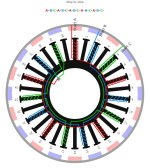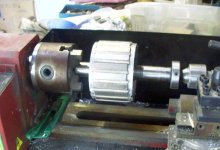JackB
10 W
I am rewinding/modifying a generator head from 120vac single phase into a 3-phase BLDC.
I think I know how to do this, but before I spend the many hours it takes to rewind, I'd like to make sure
I'm doing it right.
This generator head stator has 30 slots. Picture below after I have removed the old windings:

Given 3-phases, the poles must be divisible by 3, so I can only do 3, 5, or 10 poles.
It was planning to do 10 poles, which means winding a coil around each slot, similiar to how outrunners/hub motors are wound.
I could use some assurance on winding rotation direction and the magnet poles.
There are 2 magnets for each pole, and when alternated N-S,
there is an even number of 20 magnets, which means the N magnets all align with each pole (and S as well when rotated).
So if I understand correctly, this means all the coils should be wound the same direction, essentially ABCABCABC, etc, right?
I think I know how to do this, but before I spend the many hours it takes to rewind, I'd like to make sure
I'm doing it right.
This generator head stator has 30 slots. Picture below after I have removed the old windings:

Given 3-phases, the poles must be divisible by 3, so I can only do 3, 5, or 10 poles.
It was planning to do 10 poles, which means winding a coil around each slot, similiar to how outrunners/hub motors are wound.
I could use some assurance on winding rotation direction and the magnet poles.
There are 2 magnets for each pole, and when alternated N-S,
there is an even number of 20 magnets, which means the N magnets all align with each pole (and S as well when rotated).
So if I understand correctly, this means all the coils should be wound the same direction, essentially ABCABCABC, etc, right?



